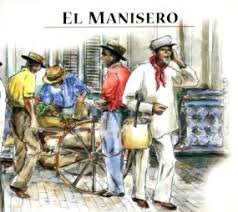Son Cubano and El Manisero
Son Cubano is the sound of Cuba. Son-pregón is the sound of a street vendor’s cry. “El Manisero” is a son-pregón based on the cry of a peanut vendor. "The Peanut Vendor" is the name of the song in English. There is a very early video of Antonió Machin singing the song. He is dressed as a peanut vendor.
Moisés Simon composed “El Manisero” in Cuba in the 1920s. Another Cuban, Rita Montaner, first recorded it for Columbia Records in 1930. It was then that "the first boom in Latin music began, opening the doors of the music industry to the entire region [Cuba and Latin America].”
The Peanut Vendor
A publishing company made $20 million from selling sheet music; Simons made only $20,000. A 78 rpm single of “El Manicero” was the first Cuban music single to sell more than one million copies. It has been recorded over 200 times; been used in numerous movies; adapted to various genres such as New Orleans jazz, ska, and reggae; and performed by an orchestra. Don Azpiazú and the Havana Casino Orchestra recorded the best-selling version of the song in 1930 with Antonió Machin, who later recorded solo versions.
“El Manicero” is in the United States National Recording Registry. It was inducted into the Latin Grammy Hall Of Fame in 2001 for being “the first American recording of an authentic Latin Dance Style.” Don Azpiazú’s recording launched a decade of “rhumba mania” and introduced U.S. listeners to Cuban rhythms and the full complement of Latin percussion instruments: maracas, claves, güiros, bongos, congas, and timbales. The U.S. recording industry mistakenly labeled the song a rhumba because it “was easy to remember.” To add to the confusion, Perez Prado recorded it on his album La Historia Del Mambo, Vol. 2.
Stan Kenton recorded a big band version that was a lasting hit. It became a staple of his repertoire.
Hollywood latched on to the song repeatedly. Here is what Hollywood does with a good Cuban song featuring Xavier Cugat and Jane Powell. Xavier Cugat was a Spanish musician and bandleader who spent his formative years in Havana, Cuba. Trained as a violinist and arranger, he was a leading figure in the popularization of Latin music. In New York City, he was the leader of the resident orchestra at the Waldorf–Astoria Hotel before and after World War II. Jane Powell was an American actress, singer, and dancer who appeared in Metro-Goldwyn-Mayer musicals in the 1940s and 50s. Here is a more sentimental movie version with Lupe Velez.
I should mention that El Manisero translates as the peanut vendor. Here are the first few lines of the song in English:
In Cuba, each merry maid
Wakes up with this serenade
Peanuts! They’re nice and hot.
Peanuts! I sell a lot.
If you haven’t got bananas don’t be blue
Peanuts in a little bag are calling you
The version of “El Manisero” by the Preservation Hall Jazz Band reminded me of a quote from Jelly Roll Morton, one of the first jazz pianists. He stressed the importance of Latin music to jazz.
You can’t make jazz without certain elements of Latin music.
“[I]f you can't manage to put tinges of Spanish in your tunes, you will never be able to get the right seasoning, I call it, for jazz.”
Here are some other versions of “El Manisero” that diverge from the style of Cuban music.
Ska version, the Skatalites
From Africa, Flavour performing “Sawa sawa sawale”
Orchestral, Havana Lyceum Orchestra
Hot, Mexican Guiter Instrumental, Los Cuates De Sinaloa
Big Band Instrumental, Mario Bauza
More Recent (2017), La Bembé y su Gozadra
Also Recent, Cuba L.A.
A Russsian couple in a studio in Nizhni Novgorod dancing to Willy Chirino’s music
